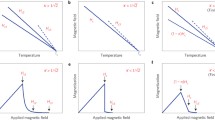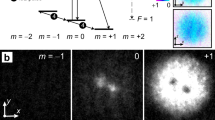Abstract
Traversing a continuous phase transition at a finite rate leads to the breakdown of adiabatic dynamics and the formation of topological defects, as predicted by the celebrated Kibble-Zurek mechanism (KZM). We investigate universal signatures beyond the KZM, by characterizing the distribution of vortices generated in a thermal quench leading to the formation of a holographic superconductor. The full counting statistics of vortices is described by a binomial distribution, in which the mean value is dictated by the KZM and higher-order cumulants share the universal power-law scaling with the quench time. Extreme events associated with large fluctuations no longer exhibit a power-law behavior with the quench time and are characterized by a universal form of the Weibull distribution for different quench rates.
Article PDF
Similar content being viewed by others
Avoid common mistakes on your manuscript.
References
T.W.B. Kibble, Topology of cosmic domains and strings, J. Phys. A 9 (1976) 1387 [INSPIRE].
W.H. Zurek, Cosmological experiments in superfluid helium?, Nature 317 (1985) 505 [INSPIRE].
T.W.B. Kibble, Some implications of a cosmological phase transition, Phys. Rept. 67 (1980) 183 [INSPIRE].
W.H. Zurek, Cosmological experiments in condensed matter systems, Phys. Rept. 276 (1996) 177 [cond-mat/9607135] [INSPIRE].
V.M.H. Ruutu et al., Vortex formation in neutron-irradiated superfluid 3He as an analogue of cosmological defect formation, Nature 382 (1996) 334 [cond-mat/9512117] [INSPIRE].
C. Baeuerle, Y.M. Bunkov, S.N. Fisher, H. Godfrin and G.R. Pickett, Laboratory simulation of cosmic string formation in the early universe using superfluid 3He, Nature 382 (1996) 332 [INSPIRE].
A. del Campo and W.H. Zurek, Universality of phase transition dynamics: Topological defects from symmetry breaking, Int. J. Mod. Phys. A 29 (2014) 1430018 [arXiv:1310.1600] [INSPIRE].
S. Deutschländer, P. Dillmann, G. Maret and P. Keim, Kibble-Zurek mechanism in colloidal monolayers, Proc. Nat. Acad. Sci. 112 (2015) 6925 [arXiv:1503.08698] [INSPIRE].
A. Keesling et al., Quantum Kibble-Zurek mechanism and critical dynamics on a programmable Rydberg simulator, Nature 568 (2019) 207 [arXiv:1809.05540] [INSPIRE].
Y. Bando et al., Probing the universality of topological defect formation in a quantum annealer: Kibble-Zurek mechanism and beyond, Phys. Rev. Res. 2 (2020) 033369 [arXiv:2001.11637].
S.A. Hartnoll, A. Lucas and S. Sachdev, Holographic quantum matter, MIT Press, Cambridge (2018).
H. Liu and J. Sonner, Holographic systems far from equilibrium: a review, arXiv:1810.02367 [INSPIRE].
J. Sonner, A. del Campo and W.H. Zurek, Universal far-from-equilibrium dynamics of a holographic superconductor, Nature Commun. 6 (2015) 7406 [arXiv:1406.2329] [INSPIRE].
H.-B. Zeng, C.-Y. Xia and H.-Q. Zhang, Topological defects as relics of spontaneous symmetry breaking in a holographic superconductor, JHEP 03 (2021) 136 [arXiv:1912.08332] [INSPIRE].
C.-Y. Xia and H.-B. Zeng, Winding up a finite size holographic superconducting ring beyond Kibble-Zurek mechanism, Phys. Rev. D 102 (2020) 126005 [arXiv:2009.00435] [INSPIRE].
A. Das, J. Sabbatini and W.H. Zurek, Winding up superfluid in a torus via Bose Einstein condensation, Sci. Rep. 2 (2011) 352 [arXiv:1102.5474] [INSPIRE].
P.M. Chesler, A.M. García-García and H. Liu, Defect Formation beyond Kibble-Zurek Mechanism and Holography, Phys. Rev. X 5 (2015) 021015 [arXiv:1407.1862] [INSPIRE].
C.N. Weiler, T.W. Neely, D.R. Scherer, A.S. Bradley, M.J. Davis and B.P. Anderson, Spontaneous vortices in the formation of Bose-Einstein condensates, Nature 455 (2008) 948 [arXiv:0807.3323].
N. Navon, A.L. Gaunt, R.P. Smith and Z. Hadzibabic, Critical dynamics of spontaneous symmetry breaking in a homogeneous Bose gas, Science 347 (2015) 167 [arXiv:1410.8487].
L. Chomaz et al., Emergence of coherence via transverse condensation in a uniform quasi-two-dimensional Bose gas, Nat. Commun. 6 (2015) 6162 [arXiv:1411.3577].
S.-Z. Lin et al., Topological defects as relics of emergent continuous symmetry and Higgs condensation of disorder in ferroelectrics, Nature Phys. 10 (2014) 970 [arXiv:1506.05021] [INSPIRE].
B. Ko, J.W. Park and Y. Shin, Kibble-Zurek universality in a strongly interacting Fermi superfluid, Nature Phys. 15 (2019) 1227 [arXiv:1902.06922] [INSPIRE].
B.I. Halperin, Statistical mechanics of topological defects, in Physics of Defects, proceedings of Les Houches, Session XXXV 1980 NATO ASI, R. Ballan, M. Kléman and J. Poirier, eds., p. 816, North-Holland Press (1981).
F. Liu and G.F. Mazenko, Defect-defect correlation in the dynamics of first-order phase transitions, Phys. Rev. B 46 (1992) 5963 [INSPIRE].
A. del Campo, Universal statistics of topological defects formed in a quantum phase transition, Phys. Rev. Lett. 121 (2018) 200601 [arXiv:1806.10646] [INSPIRE].
J.-M. Cui, F.J. Gómez-Ruiz, Y.-F. Huang, C.-F. Li, G.-C. Guo and A. del Campo, Experimentally testing quantum critical dynamics beyond the Kibble-Zurek mechanism, Comm. Phys. 3 (2020) 44 [arXiv:1903.02145].
F.J. Gómez-Ruiz, J.J. Mayo and A. del Campo, Full counting statistics of topological defects after crossing a phase transition, Phys. Rev. Lett. 124 (2020) 240602 [arXiv:1912.04679] [INSPIRE].
S.A. Hartnoll, C.P. Herzog and G.T. Horowitz, Building a holographic superconductor, Phys. Rev. Lett. 101 (2008) 031601 [arXiv:0803.3295] [INSPIRE].
A. del Campo, A. Retzker and M.B. Plenio, The inhomogeneous Kibble-Zurek mechanism: vortex nucleation during Bose-Einstein condensation, New J. Phys. 13 (2011) 083022.
K. Skenderis, Lecture notes on holographic renormalization, Class. Quant. Grav. 19 (2002) 5849 [hep-th/0209067] [INSPIRE].
E. Witten, SL(2, ℤ) action on three-dimensional conformal field theories with Abelian symmetry, in From Fields to Strings: Circumnavigating Theoretical Physics: A Conference in Tribute to Ian Kogan, (2003) [hep-th/0307041] [INSPIRE].
O. Doménech, M. Montull, A. Pomarol, A. Salvio and P.J. Silva, Emergent gauge fields in holographic superconductors, JHEP 08 (2010) 033 [arXiv:1005.1776] [INSPIRE].
P.M. Chesler and L.G. Yaffe, Numerical solution of gravitational dynamics in asymptotically Anti-de Sitter spacetimes, JHEP 07 (2014) 086 [arXiv:1309.1439] [INSPIRE].
M. Laver and E.M. Forgan, Magnetic flux lines in type-II superconductors and the ‘hairy ball’ theorem, Nat. Commun. 1 (2010) 45.
L. Le Cam, An approximation theorem for the poisson binomial distribution, Pac. J. Math. 10 (1960) 1181.
L. de Haan and A.F. Ferreira, Extreme quantile and tail estimation, in Extreme Value Theory: An Introduction, Springer New York, U.S.A. (2006), pp. 127–154, [DOI].
M. Molloy and B. Reed, The chernoff bound, in Graph Colouring and the Probabilistic Method, Springer Berlin Heidelberg, Germany (2002), pp. 43–46, [DOI].
Author information
Authors and Affiliations
Corresponding author
Additional information
Publisher’s Note
Springer Nature remains neutral with regard to jurisdictional claims in published maps and institutional affiliations.
ArXiv ePrint: 2101.02171
Rights and permissions
Open Access . This article is distributed under the terms of the Creative Commons Attribution License (CC-BY 4.0), which permits any use, distribution and reproduction in any medium, provided the original author(s) and source are credited.
About this article
Cite this article
del Campo, A., Gómez-Ruiz, F.J., Li, ZH. et al. Universal statistics of vortices in a newborn holographic superconductor: beyond the Kibble-Zurek mechanism. J. High Energ. Phys. 2021, 61 (2021). https://doi.org/10.1007/JHEP06(2021)061
Received:
Accepted:
Published:
DOI: https://doi.org/10.1007/JHEP06(2021)061




